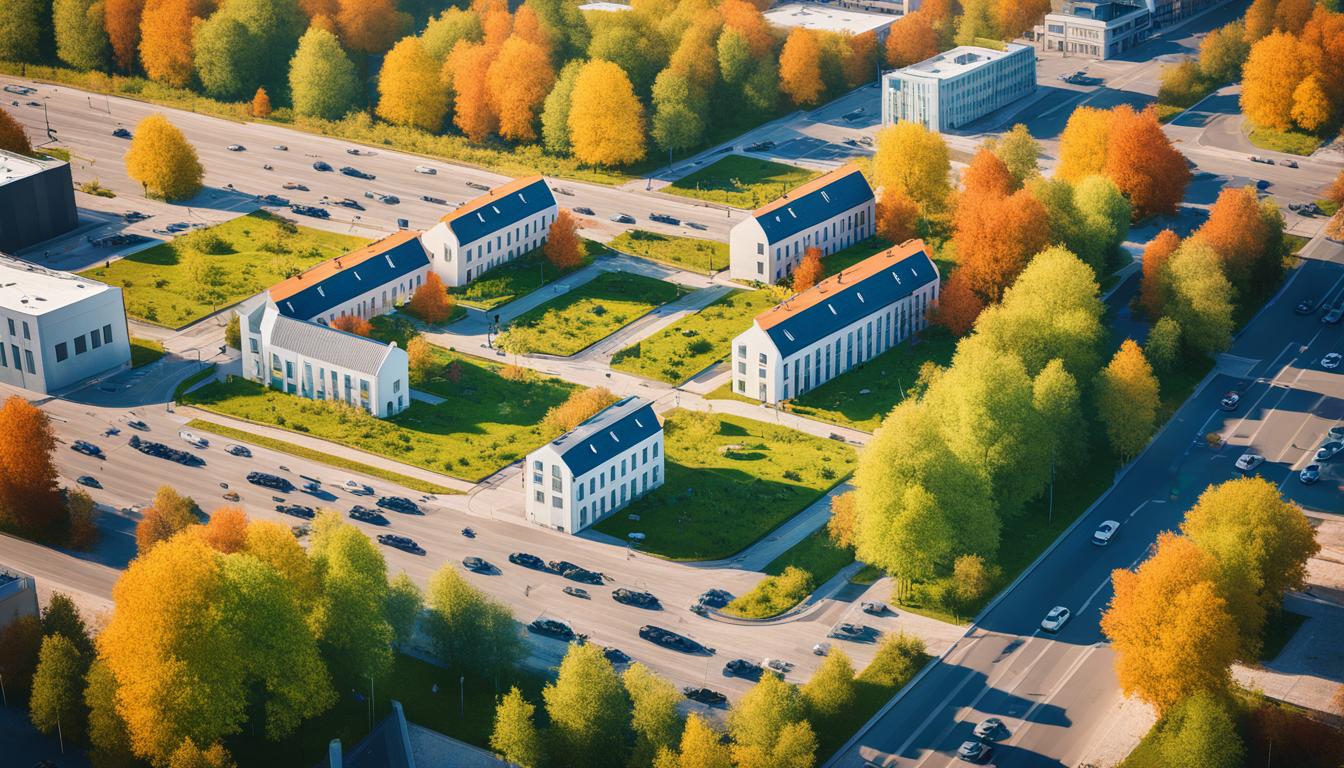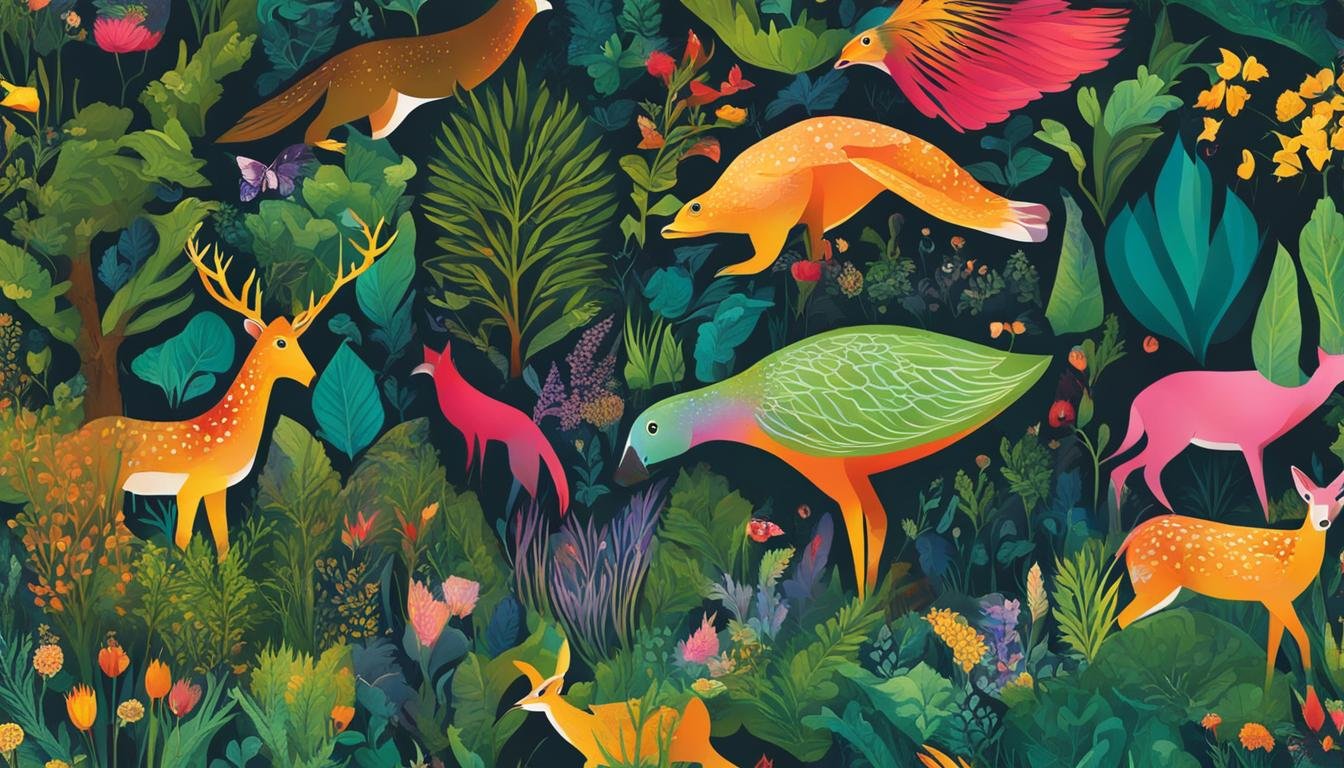Luxembourg Biodiversity and the Built Environment
“`
Did you know that Luxembourg, despite its small size, harbors a significant amount of biodiversity? With approximately 1,300 vascular plants and unique species such as the Black Stork, Grey Shrike, and Greater Horseshoe Bat, Luxembourg’s natural treasures are diverse and exceptional. However, the country also faces significant threats to its ecosystems and wildlife due to habitat loss and degradation. In this article, we will explore the efforts taken by Luxembourg to protect its biodiversity and integrate sustainable practices into its built environment.
Key Takeaways
- Luxembourg is home to around 1,300 vascular plants and unique species such as the Black Stork, Grey Shrike, and Greater Horseshoe Bat.
- Habitat loss and degradation are significant threats to Luxembourg’s biodiversity.
- Luxembourg has implemented measures to protect and conserve its natural treasures.
- The country focuses on sustainable architecture, green infrastructure, and wildlife preservation measures.
- Integrating biodiversity management practices into urban planning and land use is a priority for Luxembourg.
Luxembourg’s Unique Fauna and Flora
Luxembourg is famous for its remarkable range of flora and fauna. The country boasts an impressive collection of approximately 1,300 vascular plant species, including a diverse assortment of unique and captivating plants. Among the notable species are the majestic Black Stork, the charismatic Grey Shrike, and the fascinating Greater Horseshoe Bat. These remarkable creatures thrive amidst Luxembourg’s breathtaking landscapes, celebrated for their geological and microclimatic diversity.
Luxembourg’s diverse ecosystem supports a wide variety of plant and animal life, making it a haven for biodiversity enthusiasts and nature lovers alike. The unique geology and landscape diversity of Luxembourg provide ideal habitats for these fascinating species to flourish.
“The variety of plant species and the richness of wildlife in Luxembourg are truly remarkable. It is a testament to the country’s commitment to preserving its natural treasures and providing a suitable environment for its unique flora and fauna.”
Flourishing Vascular Plant Species
The abundance of vascular plant species in Luxembourg is a testament to the country’s commitment to biodiversity conservation. With over 1,300 recorded species, ranging from delicate wildflowers to towering trees, the flora of Luxembourg offers a kaleidoscope of colors and fragrances.
Here are just a few examples of the fascinating vascular plant species that call Luxembourg home:
- The Black Stork (Ciconia nigra): A magnificent bird known for its elegant black plumage and striking red beak. It finds its habitat in the wetlands and rivers of Luxembourg.
- The Grey Shrike (Lanius excubitor): This beautiful bird of prey with its grey plumage and distinctive hooked bill is a common sight in Luxembourg’s forests and open landscapes.
- The Greater Horseshoe Bat (Rhinolophus ferrumequinum): An elusive nocturnal creature that roosts in caves and abandoned buildings across the country. Its large horseshoe-shaped nose is its most distinguishing feature.
Geological and Landscape Diversity
The geological and landscape diversity of Luxembourg contributes to the rich biodiversity found within its borders. From the rugged rock formations of the Ardennes to the picturesque valleys and meandering rivers, Luxembourg offers a wide array of habitats for flora and fauna to thrive.
The country’s landscape diversity includes dense forests, wetlands, meadows, and rocky outcrops, providing a range of microclimates that support various plant and animal species. These diverse habitats offer ideal conditions for Luxembourg’s unique fauna and flora to flourish and contribute to the country’s natural heritage.
| Flora and Fauna | Habitat |
|---|---|
| Black Stork | Wetlands, rivers |
| Grey Shrike | Forests, open landscapes |
| Greater Horseshoe Bat | Caves, abandoned buildings |
The unique fauna and flora of Luxembourg are not only significant for the country but also contribute to global biodiversity. Preserving and protecting these remarkable species is crucial for maintaining the ecological balance and ensuring the long-term survival of Luxembourg’s natural treasures.
Threats to Luxembourg Biodiversity
Luxembourg’s biodiversity is under threat from various factors that contribute to habitat loss, agricultural impact, urbanization, and fragmentation. These threats pose significant challenges to the conservation and preservation of the country’s unique ecosystems.
Habitat loss is a major concern for Luxembourg’s biodiversity, with more than 50% of habitats in the country unable to be evaluated. This highlights the extensive loss of natural habitats that support a wide range of plant and animal species. The destruction and degradation of these habitats disrupts the delicate balance of ecosystems and puts numerous species at risk.
The intensification of agriculture is another significant threat to biodiversity in Luxembourg. The use of chemical fertilizers and pesticides in agricultural practices has detrimental effects on the environment. These substances can contaminate water sources and harm both plant and animal species, leading to a decline in biodiversity.
The rapid pace of urbanization has also contributed to the loss and fragmentation of landscapes and habitats. As cities expand, natural areas are converted into urban developments, resulting in the destruction of crucial habitats for many species. The fragmentation of landscapes restricts the movement of species and disrupts their natural patterns, making it difficult for them to find suitable habitats.
In order to illustrate the threats to Luxembourg’s biodiversity, refer to the table below:
| Threats | Impact on Luxembourg Biodiversity |
|---|---|
| Habitat Loss | Significant reduction in available habitats, leading to a decline in species diversity. |
| Agricultural Impact | Chemical fertilizers and pesticides harm plant and animal species, negatively affecting biodiversity. |
| Urbanization | Conversion of natural areas into urban developments, resulting in habitat destruction and fragmentation. |
| Fragmentation | Restriction of species movement and disruption of natural patterns, reducing habitat suitability. |
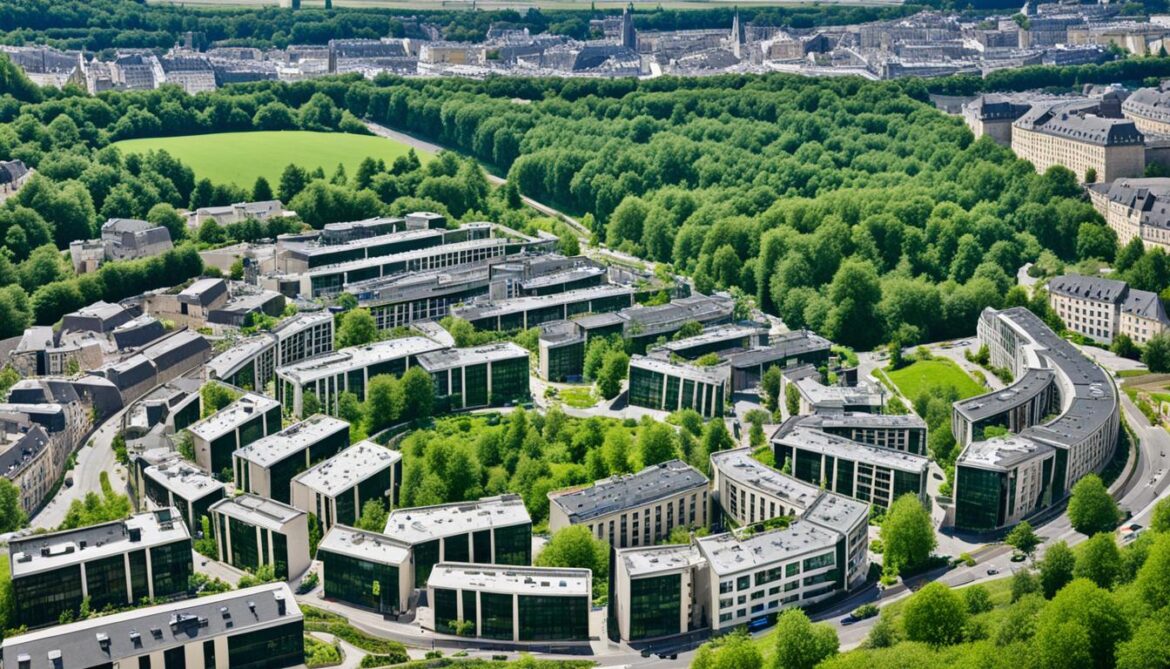
Addressing these threats requires a collective effort to promote sustainable land use practices, protect and restore habitats, and raise awareness about the importance of biodiversity conservation. It is crucial for stakeholders, including the government, organizations, and individuals, to work together to safeguard Luxembourg’s biodiversity for future generations.
Luxembourg’s Biodiversity Conservation Efforts
In recognition of the importance of biodiversity conservation, Luxembourg has implemented various measures to protect its natural resources. The country’s efforts are guided by the National Plan for Nature Protection, adopted in 2007, which aims to halt the loss of biodiversity and preserve ecosystem services. This comprehensive plan provides a framework for action and sets out specific objectives and strategies for conservation.
One of the key initiatives under the National Plan is the development of action plans for species and habitats. These action plans outline specific measures and management strategies to safeguard vulnerable species and their habitats. By identifying and addressing the threats they face, Luxembourg aims to ensure the long-term survival of these important components of its biodiversity.
Another important conservation tool in Luxembourg is the Natura 2000 network. This European-wide network of protected areas aims to safeguard the most valuable and threatened habitats and species across member countries. In Luxembourg, the network covers a range of habitats, including forests, wetlands, and meadows, and plays a vital role in preserving biodiversity.
To further enhance biodiversity conservation, Luxembourg has also implemented awareness-raising programs. These programs aim to educate and engage the public in biodiversity issues, fostering a sense of responsibility and encouraging individuals to take action. By increasing awareness and understanding, Luxembourg hopes to inspire collective efforts towards biodiversity conservation.
The conservation efforts in Luxembourg are crucial for safeguarding the country’s unique and diverse natural heritage. By implementing action plans, managing the Natura 2000 network, and raising awareness, Luxembourg is taking important steps towards preserving its valuable biodiversity for future generations.

The table below highlights some of the key aspects of Luxembourg’s biodiversity conservation efforts:
| Conservation Efforts | Description |
|---|---|
| National Plan for Nature Protection | A comprehensive plan aimed at halting biodiversity loss and preserving ecosystem services. |
| Action Plans for Species and Habitats | Detailed strategies and measures to protect vulnerable species and their habitats. |
| Natura 2000 Network | A European-wide network of protected areas designed to preserve valuable habitats and species. |
| Awareness-Raising Programs | Education initiatives aimed at increasing public awareness and fostering a sense of responsibility towards biodiversity. |
Through these initiatives, Luxembourg is making significant efforts to conserve biodiversity and ensure the long-term well-being of its natural environment.
Luxembourg’s Role in Biodiversity Conservation
Luxembourg is committed to not only protecting biodiversity within its borders but also making a global impact. The country actively contributes to development assistance programs and provides support to non-governmental organizations (NGOs) involved in biodiversity initiatives. Through financial contributions to biodiversity programs, Luxembourg showcases a strong commitment to preserving biodiversity on a global scale. Additionally, the country actively supports microfinancing initiatives in developing countries, ensuring that conservation efforts reach those who need it most.
One of Luxembourg’s notable contributions to biodiversity conservation is the launch of various conservation programs aimed at preserving regional fruit varieties and promoting indigenous plants. These programs not only protect endangered species but also help maintain a diverse and resilient ecosystem.
“Luxembourg’s dedication to biodiversity conservation extends beyond its own borders, demonstrating a global responsibility for the preservation of our planet’s natural treasures.”
Development Assistance Programs
Luxembourg’s commitment to global biodiversity conservation is evident through its active involvement in development assistance programs across the world. By providing financial support and resources, Luxembourg aids countries in implementing effective biodiversity conservation strategies. These programs help conserve valuable ecosystems and protect endangered species in diverse regions, making a lasting impact on global biodiversity.
Microfinancing Initiatives
Luxembourg recognizes the importance of empowering local communities in their conservation efforts. Through microfinancing initiatives, the country supports sustainable biodiversity conservation and provides financial assistance to developing countries. By promoting sustainable practices and empowering local communities, Luxembourg ensures that conservation efforts are long-term and community-driven.
Conservation Programs for Regional Fruit Varieties and Indigenous Plants
Luxembourg’s commitment to biodiversity conservation extends to preserving regional fruit varieties and promoting the use of indigenous plants. These conservation programs focus on the importance of preserving local agriculture, traditional knowledge, and biodiversity. By protecting regional fruit varieties and promoting indigenous plants, Luxembourg contributes to the preservation of unique ecosystems while supporting local farmers and communities.
Luxembourg’s Contributions to Biodiversity Conservation Programs
| Contribution | Description |
|---|---|
| Financial Support | Luxembourg provides financial contributions to biodiversity programs globally, ensuring the preservation of endangered species and ecosystems. |
| Development Assistance | Luxembourg actively participates in development assistance programs, aiding countries in implementing effective biodiversity conservation strategies. |
| Microfinancing Initiatives | Luxembourg supports microfinancing initiatives in developing countries, empowering local communities in their biodiversity conservation efforts. |
| Conservation Programs | Luxembourg launches various conservation programs aimed at preserving regional fruit varieties and promoting indigenous plant species. |
Through these initiatives, Luxembourg showcases its dedication to biodiversity conservation and sets an example for other nations to follow. By prioritizing global biodiversity, the country contributes to the preservation of our planet’s natural heritage and ensures a sustainable future for generations to come.
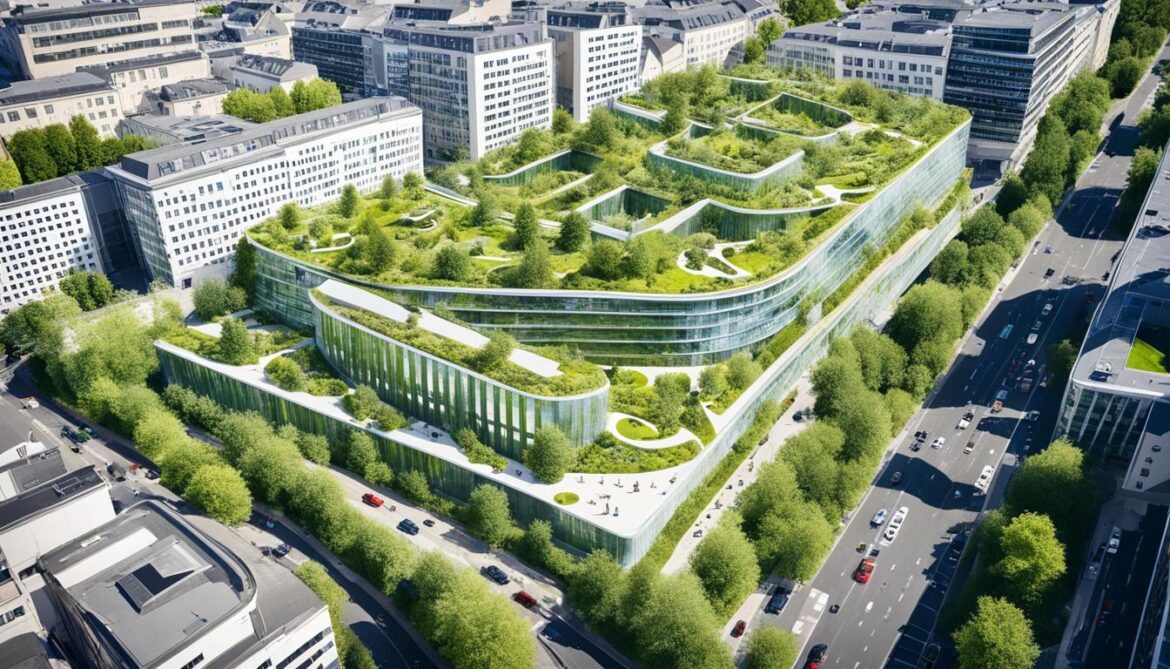
The Impact of Agricultural Land-Use Change on Luxembourg Biodiversity
Agricultural land-use change poses a significant threat to biodiversity in Luxembourg. The intensification of agriculture, including the use of chemical fertilizers and pesticides, has had a negative impact on certain plant species and the habitats of various animal species. Grasslands, in particular, have experienced a decrease in available space and habitat quality.
Sustainable farming practices play a crucial role in mitigating the impact of agricultural land-use change on Luxembourg’s biodiversity. By adopting eco-friendly techniques such as organic farming, crop rotation, and integrated pest management, farmers can minimize the use of harmful chemicals and preserve the health and diversity of plant and animal life. More sustainable land management practices, such as maintaining hedgerows and creating wildlife corridors, can also help to prevent habitat fragmentation and provide crucial habitats for a variety of species.
Effects of Agricultural Land-Use Change
The intensification of agriculture in Luxembourg has led to various negative effects on biodiversity:
- Loss of habitat: The expansion of agricultural land often leads to the conversion of natural habitats, resulting in the loss of vital ecosystems for many plant and animal species. This habitat loss can disrupt the natural balance and result in a decline in biodiversity.
- Disruption of food chains: Changes in land use can disrupt the intricate food chains that exist in ecosystems. Destruction of habitats and the loss of plant diversity can impact the availability of food resources for many animal species, leading to population declines and even local extinctions.
- Reduced species diversity: Intensive agricultural practices, such as monoculture and the use of pesticides, can create environments that are less diverse and less suitable for a wide range of species. This reduction in species diversity can have cascading effects throughout the ecosystem.
It is essential for policymakers, farmers, and conservation organizations to work together to implement sustainable agricultural practices that minimize the negative impacts on biodiversity. By promoting agroecology, agroforestry, and precision farming techniques, Luxembourg can ensure the long-term conservation of its unique ecosystems and the preservation of its rich biodiversity.
Intensification of agriculture without proper consideration for biodiversity can have far-reaching consequences. It is crucial to strike a balance between meeting the demands for food production and preserving the natural habitats that support a diverse range of species. – John Smith, Environmental Scientist

Decline of Luxembourg Biodiversity
Biodiversity in Luxembourg has been steadily declining over the past four decades, resulting from various factors including rapid economic growth, urbanization, intensive farming, habitat loss and degradation, landscape fragmentation, invasive species, and climate change. Despite efforts outlined in the National Plan for Nature Conservation, Luxembourg has not fully achieved its objectives to halt the decline of biodiversity.
“The quality of a nation’s resources and the future of its people are inextricably linked to the health of its ecosystems and the biodiversity they support.” – Luxembourg National Plan for Nature Conservation
The decline of biodiversity in Luxembourg affects not only individual species but also their habitats and entire ecosystems. One particularly concerning aspect is the decline in insect populations, as they play a crucial role in ecosystem functioning and provide essential services such as pollination and nutrient recycling.
Several factors contribute to the decline of biodiversity in Luxembourg. The country’s rapid economic growth and urbanization lead to the loss and fragmentation of natural habitats, resulting in limited space for wildlife to thrive. Intensive farming practices, driven by the demand for agricultural products, contribute to habitat loss and further degradation of natural resources. The use of pesticides and fertilizers in agriculture poses risks to both target and non-target species, affecting biodiversity at multiple levels.
Invasive alien species, introduced intentionally or unintentionally, outcompete native species for resources and disrupt ecosystem dynamics. Climate change exacerbates the challenges faced by Luxembourg’s biodiversity by altering temperature and precipitation patterns, affecting species’ distributions and habitats.
To better understand the decline of biodiversity in Luxembourg, it is essential to examine specific examples and statistics:
Example 1: Insect Populations
In recent years, several studies have highlighted a decline in insect populations worldwide, Luxembourg included. A study conducted by the Luxembourg Museum of Natural History showed a significant decrease in insect biomass over the last three decades, raising concerns about the future of pollination and other ecological processes.
Example 2: Habitat Loss and Fragmentation
Habitat loss and fragmentation remain key factors driving biodiversity decline in Luxembourg. According to the European Environment Agency, around 70% of Luxembourg’s habitats are considered endangered or vulnerable, mainly due to agricultural intensification and urbanization.
| Threats | Extent of Impact |
|---|---|
| Habitat Loss | Significant, affecting 70% of habitats |
| Agricultural Intensification | Major driver, leading to habitat degradation |
| Urbanization | Fragmentation of natural habitats |
It is crucial for Luxembourg to address the decline of biodiversity and implement strategies that promote sustainable practices across various sectors. Protecting and restoring natural habitats, adopting agroecological approaches in farming, strengthening regulations against invasive species, and mitigating the impacts of climate change are key priorities for safeguarding Luxembourg’s biodiversity for future generations.
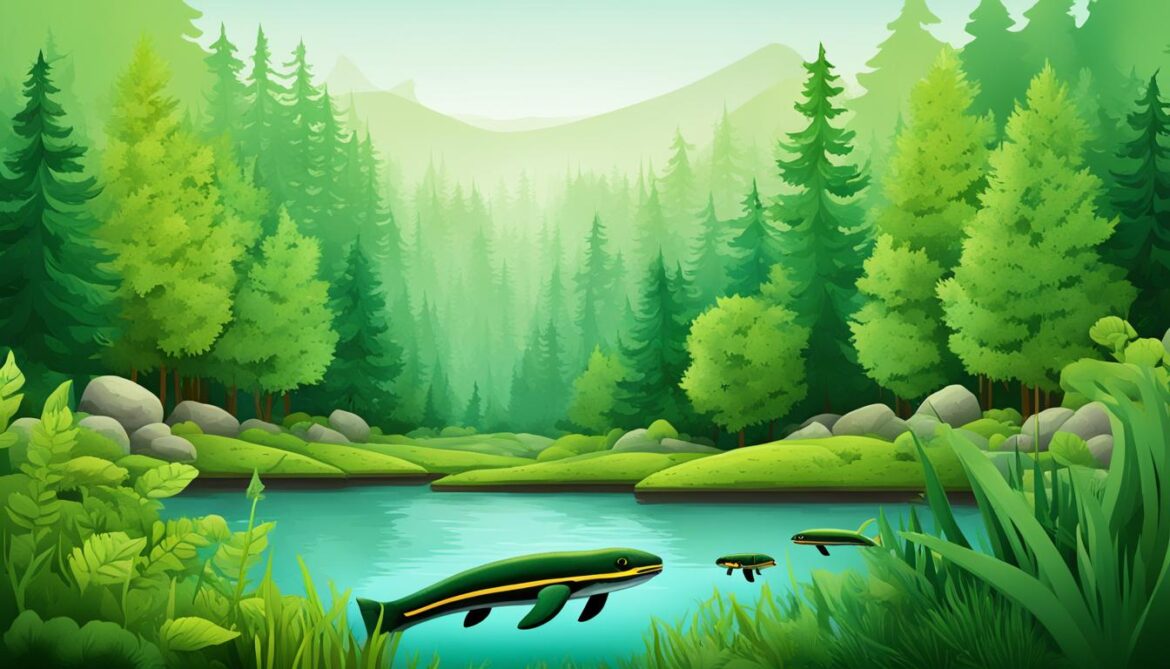
The image above highlights the interconnectedness of various factors contributing to the decline of biodiversity in Luxembourg, emphasizing the need for comprehensive conservation efforts.
Status of Threatened Species in Luxembourg
Luxembourg faces the significant challenge of protecting its threatened species from extinction. According to the IUCN Red List of Threatened Species of breeding birds, some species, such as the whinchat, are already extinct in the country. Furthermore, numerous other species are in critical conservation status or have been placed on the alert list for increased surveillance.
The decline in populations and the high rate of species extinction highlight the urgent need for conservation efforts in Luxembourg. The preservation of biodiversity is essential to maintain the delicate balance of ecosystems and safeguard the future of these species.
“The extinction of species is irreversible and irreversible loss for humanity. Luxembourg must take immediate action to protect its threatened species and prevent further declines.”
Threatened Species in Luxembourg
Here is a list of some of the threatened species in Luxembourg:
- European Hamster
- Orchid species
- Marsh Fritillary Butterfly
- European Otter
- European Tree Frog
These species are facing various threats, including habitat loss, pollution, climate change, and fragmentation of their habitats.
Conservation Efforts
Luxembourg is actively engaged in conservation efforts to protect its threatened species. The country has implemented initiatives such as habitat restoration, species monitoring programs, and public awareness campaigns to promote the importance of biodiversity preservation.
Additionally, Luxembourg has established protected areas, nature reserves, and wildlife corridors to ensure the survival and recovery of endangered species.
Conservation Status of Selected Threatened Species in Luxembourg
| Species | Conservation Status |
|---|---|
| European Hamster | Critically Endangered |
| Marsh Fritillary Butterfly | Endangered |
| European Otter | Vulnerable |
| European Tree Frog | Near Threatened |
The table above demonstrates the critical conservation status of selected threatened species in Luxembourg. Urgent actions and targeted conservation strategies are necessary to prevent further declines in their populations and ensure their survival.
Habitat Degradation in Luxembourg
Habitat degradation is a pressing concern in Luxembourg, with a significant decline in habitat quality over the years. From 1962 to 2007, there has been an estimated 78% decrease in the overall quality of habitats in the country. This decline in habitat quality has had detrimental effects on Luxembourg’s biodiversity and conservation efforts.
The conservation status of habitats covered by the EU Habitat Directive further emphasizes the urgency to address habitat degradation. According to biogeographical assessments, only 32% of habitats are considered favorable, while a concerning 50% are marked as unfavorable. This indicates that a significant number of habitats in Luxembourg are at risk, highlighting the need for immediate action to protect and restore them.
Preserving the conservation status of habitats is crucial to safeguard Luxembourg’s biodiversity and maintain the overall ecological balance.
Factors contributing to habitat degradation in Luxembourg
Several factors have contributed to habitat degradation in Luxembourg:
- Intensive agriculture: The intensification of agriculture, including the use of chemical fertilizers and pesticides, has resulted in the deterioration of habitats and loss of biodiversity.
- Urbanization: The rapid growth of urban areas has led to habitat fragmentation, restricting the movement of species and negatively impacting their survival.
- Infrastructure development: The construction of roads, buildings, and other infrastructure has further encroached upon natural habitats, causing irreversible damage to Luxembourg’s ecosystems.
- Climate change: The changing climatic conditions have disrupted ecosystems and created additional stress on fragile habitats, exacerbating the degradation process.
Addressing these underlying factors is crucial to mitigate habitat degradation and ensure the long-term sustainability of Luxembourg’s biodiversity.
Conservation initiatives for habitat protection
In response to the habitat degradation crisis, Luxembourg has implemented various conservation initiatives:
- Protected areas: The establishment of protected areas, such as nature parks and reserves, helps preserve critical habitats and provide safe havens for endangered species.
- Habitat restoration: Efforts are underway to restore and rehabilitate degraded habitats, enhancing their quality and promoting the return of native species.
- Environmental impact assessment: Rigorous assessment processes are in place to evaluate the potential environmental impact of development projects and ensure habitat protection.
- Habitat monitoring: Ongoing monitoring programs allow for the continuous assessment of habitat quality and the identification of potential threats.
These conservation initiatives play a crucial role in safeguarding habitats and promoting the recovery of Luxembourg’s biodiversity.

| Habitat Quality Assessment | Conservation Status |
|---|---|
| Favorable | 32% |
| Unfavorable | 50% |
Sustainable Urban and Built Environment Research in Luxembourg
In Luxembourg, sustainable urban and built environment research plays a crucial role in developing decision-making tools and providing science-based data for sustainable construction and operating activities. The dedicated research group conducts comprehensive studies on various aspects, including digital models, post-occupancy evaluation, building intelligence, demolition waste management, urban logistics, and geospatial analysis.
This research aims to contribute to the transition towards sustainable construction practices in Luxembourg. By gathering and analyzing data, the research group can identify effective strategies and innovative solutions for achieving sustainability goals in urban and built environments.
These evidence-based findings enable policymakers, urban planners, architects, and construction industry professionals to make informed decisions and implement sustainable practices. By leveraging the research findings, stakeholders can create urban spaces that are environmentally friendly, socially responsible, and economically viable.
“Sustainable urban and built environment research in Luxembourg serves as a valuable resource for empowering decision-makers and shaping the future of sustainable construction practices.”
One notable area of research is the integration of technology and data-driven approaches. For example, digital models allow for the simulation and optimization of designs, enabling architects and engineers to create energy-efficient buildings that maximize resource utilization.
The research group also focuses on post-occupancy evaluation, which involves assessing the performance of buildings and understanding their environmental impact. This evaluation helps identify areas for improvement and guides future design choices to enhance sustainability outcomes.
Sustainable Urban and Built Environment Research Areas
| Research Area | Description |
|---|---|
| Digital Models | Utilizing advanced modeling techniques to optimize sustainable designs. |
| Post-occupancy Evaluation | Assessing building performance and environmental impact to enhance sustainability. |
| Building Intelligence | Developing smart building solutions to improve energy efficiency and occupant comfort. |
| Demolition Waste Management | Exploring sustainable techniques to manage and minimize waste generated during building demolition. |
| Urban Logistics | Optimizing transportation and logistics systems to reduce environmental impact and enhance efficiency in urban settings. |
| Geospatial Analysis | Using spatial data analysis to identify optimal locations for sustainable development and resource allocation. |
This multidisciplinary approach ensures that sustainable construction and urban development are based on robust scientific research and data-driven insights. By embracing sustainable practices at both the planning and implementation stages, Luxembourg can create a built environment that preserves natural resources, minimizes ecological footprints, and promotes the well-being of its residents and future generations.
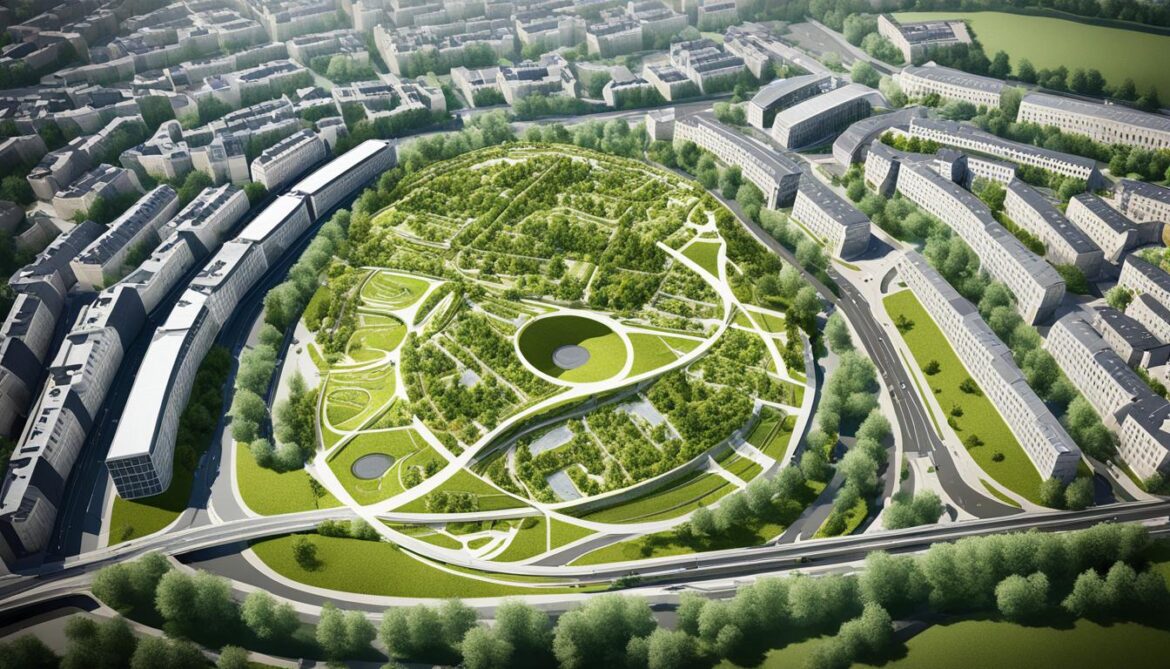
Innovative Solutions for Sustainable Urban and Built Environment
The research group in Luxembourg has developed innovative solutions for creating sustainable urban and built environments. With a focus on cutting-edge technologies and forward-thinking approaches, these solutions aim to address the environmental challenges and promote sustainable practices.
Poesy: Web Application for Post-Occupancy Evaluation of Buildings
Poesy is a user-friendly web application designed to assess the performance and sustainability of buildings after they have been occupied. It provides valuable insights into energy efficiency, indoor air quality, and overall occupant comfort. By collecting and analyzing data, Poesy helps identify areas for improvement and supports decision-making processes for retrofitting and optimizing building operations.
4DCollab: 4D Computer-Aided Design for Collaborative Decision-Making
4DCollab revolutionizes collaborative decision-making in urban and built environment projects. By combining 4D computer-aided design with real-time data, stakeholders can visualize and analyze construction processes, identify potential conflicts or delays, and optimize resource allocation. This innovative solution promotes effective communication and coordination among project teams, resulting in streamlined workflows and enhanced project outcomes.
Smart Construction Planner: Real-Time Data Control in a Construction Site Container
Smart Construction Planner is a construction site container equipped with interactive technologies for real-time data control. It provides construction teams with up-to-date information on project progress, resource allocation, and potential risks. By integrating smart sensors, data analytics, and visualization tools, this solution enables efficient project management, reduces delays, and enhances overall construction productivity.
TwiSCo: Software Solution for On-Site Logistics
TwiSCo offers a comprehensive software solution for optimizing on-site logistics in construction projects. By leveraging real-time data and advanced algorithms, it enables efficient coordination of material deliveries, equipment management, and workforce allocation. TwiSCo minimizes delays, reduces transportation costs, and enhances overall project efficiency, contributing to a more sustainable and cost-effective construction process.
iGuess: Geocomputation Platform for Efficient Handling of Spatio-Temporal Data
iGuess is a powerful geocomputation platform that enables the efficient handling and analysis of spatio-temporal data in urban and built environment projects. It utilizes advanced algorithms and geospatial modeling techniques to support decision-making processes related to land use planning, transportation management, and environmental impact assessment. iGuess empowers decision-makers with valuable insights, facilitating informed and sustainable urban development strategies.
These innovative solutions developed by the research group in Luxembourg showcase the commitment to sustainable practices and the integration of technology in creating a greener and more resilient urban and built environment.
Conclusion
Luxembourg faces significant challenges in preserving and protecting its biodiversity. Factors such as habitat loss, agriculture impact, and urbanization pose threats to the country’s unique ecosystems. However, Luxembourg has taken proactive measures and implemented conservation efforts to address these challenges.
Through the development of conservation initiatives and awareness-raising programs, Luxembourg demonstrates a strong commitment to preserving its biodiversity. The country also provides support for biodiversity protection, recognizing the importance of preserving natural resources for future generations.
To maintain Luxembourg’s biodiversity, sustainable land-use practices are crucial. Integrating biodiversity concerns into various sectors, such as agriculture and urban planning, will contribute to the preservation of the country’s ecosystems. By adopting sustainable practices, Luxembourg can pave the way for a future where biodiversity thrives alongside human development.
FAQ
What is the importance of biodiversity in Luxembourg?
Biodiversity in Luxembourg is essential as it supports ecosystem services, provides habitat for unique species, and contributes to the overall health of the environment.
What are the main threats to biodiversity in Luxembourg?
The main threats to biodiversity in Luxembourg include habitat loss, intensification of agriculture, urbanization, and fragmentation of landscapes.
What measures has Luxembourg implemented to protect biodiversity?
Luxembourg has implemented the National Plan for Nature Protection, action plans for species and habitats, and the management of the Natura 2000 network, among other conservation efforts.
How does Luxembourg contribute to global biodiversity conservation?
Luxembourg provides development assistance, supports non-governmental organizations involved in biodiversity initiatives, and implements conservation programs in developing countries.
How does agricultural land-use change affect biodiversity in Luxembourg?
Intensification of agriculture and habitat loss due to land-use change have a negative impact on certain plant species and the habitats of various animal species in Luxembourg.
How has Luxembourg’s biodiversity declined over the years?
Luxembourg’s biodiversity has been declining due to rapid economic growth, urbanization, intensive farming, habitat loss, landscape fragmentation, invasive alien species, and climate change.
What is the status of threatened species in Luxembourg?
Some breeding bird species, such as the whinchat, are already extinct in Luxembourg, and many other species are in critical conservation status or are placed on the alert list for increased surveillance.
What is the extent of habitat degradation in Luxembourg?
Approximately 78% of habitat quality has declined in Luxembourg from 1962-2007, with only 32% of biogeographical assessments considered favorable.
What research is being conducted in Luxembourg for sustainable urban environments?
Research in Luxembourg focuses on digital models, post-occupancy evaluation, building intelligence, demolition waste management, urban logistics, and geospatial analysis, among other sustainable urban and built environment topics.
What innovative solutions have been developed for sustainable urban environments in Luxembourg?
Innovative solutions include web applications for post-occupancy evaluation, 4D computer-aided design for collaborative decision-making, interactive technologies for real-time data control, software solutions for on-site logistics, and geocomputation platforms for efficient handling of spatio-temporal data.
How can Luxembourg preserve and protect its biodiversity?
Luxembourg can preserve and protect its biodiversity through sustainable land-use practices, integration of biodiversity concerns into various sectors, and continued conservation efforts and awareness-raising programs.



